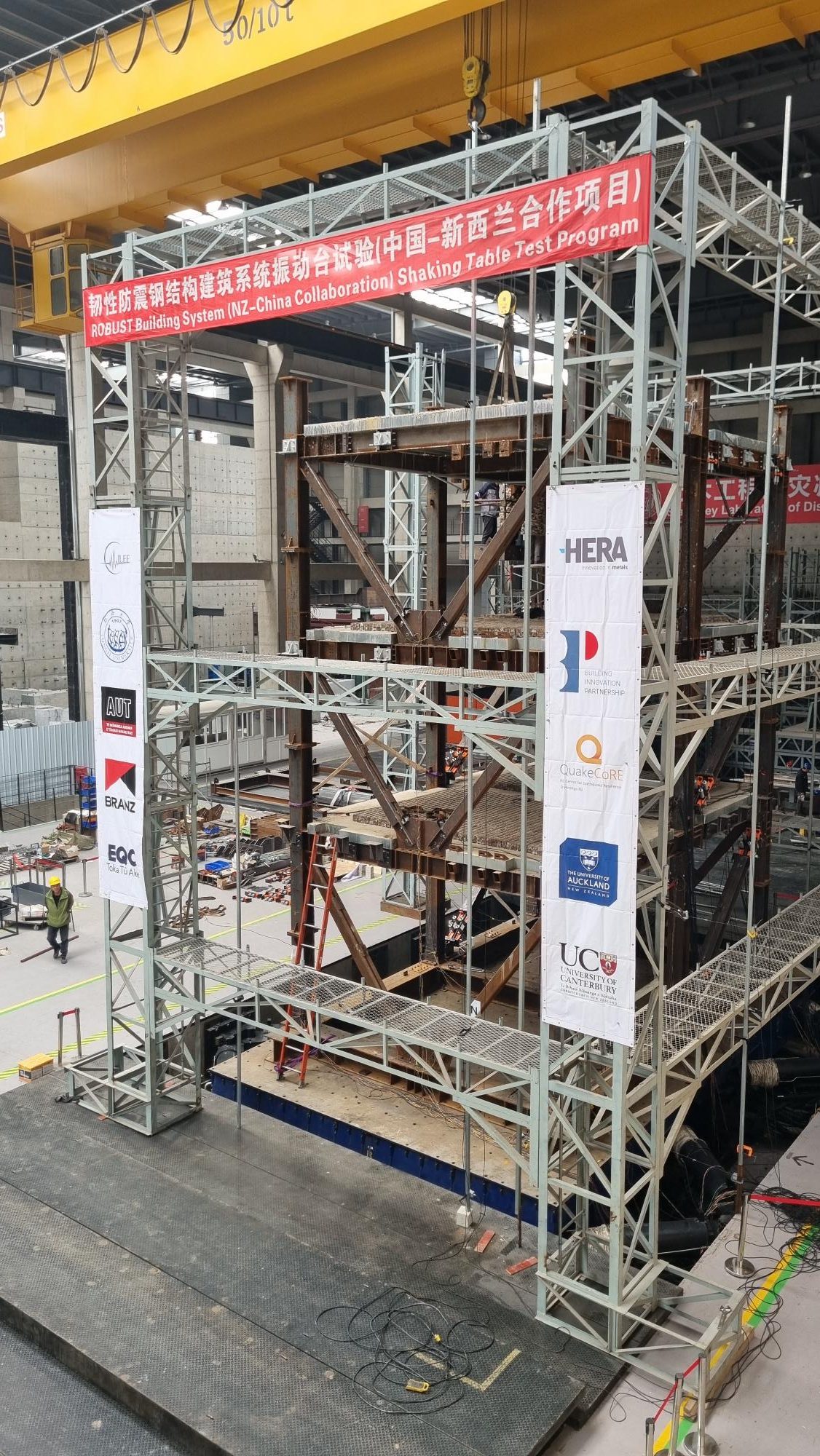HERA and the HERA Foundation are pleased to share that testing has finally been able to begin on the ROBUST building systems project.
The ROBUST building systems project was initially developed in collaboration with the International Laboratories for Earthquake Engineering (ILEE) in Shanghai in 2018.
Unfortunately, significant delays during the COVID shutdowns in both Aotearoa, New Zealand, and China has meant we have not been able to progress forward until now.
About the project
The ROBUST building systems project involves testing of three-storey 9m tall, 8.5m x 5m plan friction structures on a large shaking table to understand their responsiveness in seismic events.
Friction within the connections dissipates the earthquake energy entering the structure. This is different from conventional systems, which generally rely on the yielding of steel. Here, the shaking elements damaged by yielding likely need replacement. With frictional structures, the building can be reinstated with much less effort and cost.
The pioneering of many of early friction connections were conducted in Aotearoa by Professor Charles Clifton whilst working at HERA and undertaking his PhD part time at the University of Auckland, and they are now being used around the world. Of note, the Sliding Hinge Joint with Asymmetric Friction connections (commonly known as the SHJ) which are detailed in HERA Report R4-134.
Nine different building configurations are tested with different friction connection types. The scale, and the range of systems used in a realistic structure, make this test program a world first and likely the most complex full size building to be shake table tested worldwide.
It is expected that this research will lead to industry having confidence in the performance of these economical buildings which can be used without major repair after a number of earthquakes. It is also showing important characteristics of whole building system behaviour that cannot be determined from small-scale component testing or simulated in modelling.
Having now been placed on the large multidirectional shaking tables at the Jiading Campus of Tongji University in Shanghai for testing, the first five seismic resisting configurations have already performed well when subject to earthquake shaking more than 25% greater than the Wellington ultimate limit state design earthquake intensity. These include moment frame, tension-only brace, and tension-compression brace configurations using Resilient Slip Friction Joint (RSFJ) connections, asymmetric friction connections with and without conical spring washers (CSWs), and symmetric friction connections with and without CSWs.
Preparation for tests with two further seismic resisting systems, including a full range of building non-skeletal elements (NSE), is underway, and we are excited to see what the testing results will demonstrate. Preparations and testing are expected to last until March, with preliminary testing results available in the next few weeks.
Supporting researching
In collaboration with nine other sponsors both nationally and in China, as well as many other material and in-kind support and expertise – HERA and the HERA Foundation are proud to support research such as this as it leads to real-world applications for the construction industry to make structures more resilient in seismic events for our communities.
So far the test program has already garnered wide international attention through the many innovative new concepts related to structural earthquake engineering that have been developed. It is a testament to the tenacity of the researchers involved and it is great to see this research reach the milestone of laboratory testing!
Congratulations to Greg MacRae and Liang-Jiu JIA (Chinese PI, Tongji University) and the full team including Charles Clifton (UoA), Rajesh Dhakal (UoC), Shahab Ramhormozian (AUT), Geoff Rodgers (UoC), Pierre Quenneville (UoA), and Ping Xiang (Tongji University), Zhenduo Yan (Project Manager, AUT) and many students and other collaborators for reaching this achievement. We are certainly looking forward to seeing the results and understanding what next steps will be!
For more information please contact Gregory MacRae: (gregory.macrae@canterbury.ac.nz)

